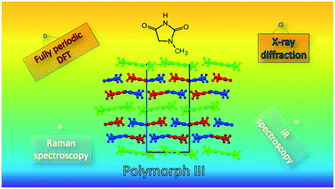Polymorphism in 1-methylhydantoin: investigation by periodic DFT calculations and characterization of the third polymorph†
Abstract
In previous studies [Puszyńska-Tuszkanow et al. Polyhedron, 2011, 30(12), 2016; Nogueira et al. J. Phys. Chem. A, 2014, 118(31), 5994; Nogueira et al., J. Mol. Struct., 2017, 1148, 111], two different polymorphs of 1-methylhydantoin (1-MH, C4H6N2O2) were identified (forms I and II) and characterized using infrared and Raman spectroscopies, as well as by X-ray diffraction. In this work, a new polymorph of the compound (form III) is described. The new polymorph was characterized spectroscopically and its structure was determined for the first time by single crystal X-ray diffraction. Very interestingly, the crystal of polymorph III was found to exhibit a high-Z′ (Z′ = 3) asymmetric unit and 12 molecules in the unit cell (Z = 12), which contrasts with the simpler crystal structures found previously for forms I and II (Z = 4; Z′ = 1). Besides, a thorough study of the polymorphism of 1-MH was performed with the help of state-of-the-art first principles fully periodic calculations of the structure, as well as infrared and Raman spectra of the different polymorphs of the compound. Marker-bands in the infrared and Raman spectra of the polymorphs are proposed for fast spectroscopic identification of the polymorphs.



 Please wait while we load your content...
Please wait while we load your content...